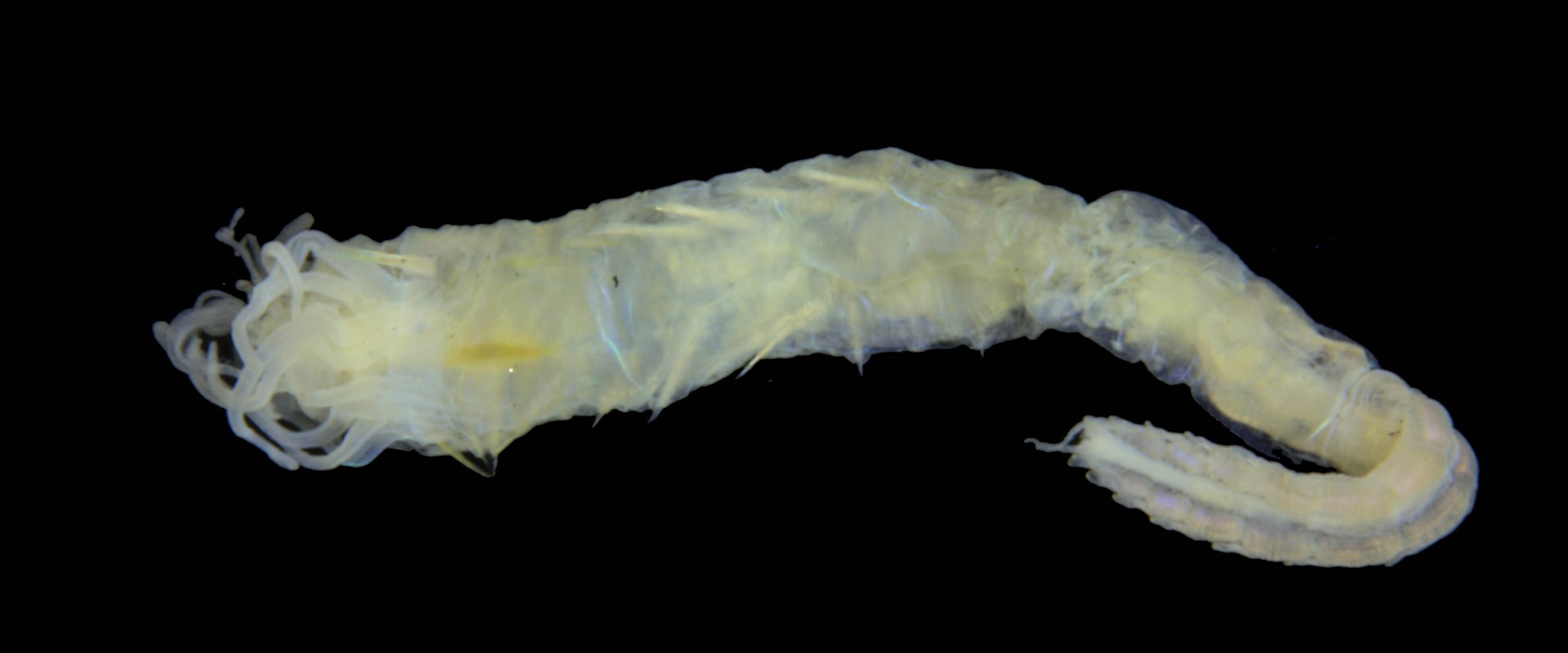There’s a worm at the bottom of the sea – and it’s been discovered off the Scottish coast by a team of scientists from the Joint Nature Conservation Committee (JNCC), Marine Scotland Science (MSS) and Thomson Environmental Consultants. But this isn’t an ordinary worm – the newcomer has a unique anatomy with its eyes in its head and in its bottom.
This new species, now given the scientific name Ampharete oculicirrata, was collected by scientists from JNCC and MSS whilst surveying the West Shetland Shelf Marine Protected Area. The West Shetland Shelf MPA has been designated to protect a wide variety of important sand and gravel habitats and is equivalent in size to the Cairngorm National Park. The survey was the first to explore the animals within and on the seabed in this area and marks the beginning of a programme of long-term monitoring. As part of this undertaking, sandy areas of previously unexplored seabed were targeted for detailed examination by the scientists on board the research vessel MRV Scotia. During the identification process back onshore it became apparent that a completely unknown species of worm was present.
The worm was identified by a team led by Ruth Barnich of Thomson Environmental Consultants, Julio Parapar from the University of La Coruña and Juan Moreira from the Autonomous University of Madrid. Now it’s been officially identified, our wiggly friend has found a new home in the collections of National Museums Scotland in Edinburgh.
Jessica Taylor, Marine Evidence Advisor from JNCC, said:
“This new species is an exciting and interesting addition to the work we do in Marine Protected Areas. The fact that it was found in relatively shallow depths, relatively close to the Scottish coastline, shows just how much more there is to understand about the creatures that live in our waters.
“I’m excited about future JNCC and Marine Scotland surveys and what they may reveal. And it’s great that specimens of the new species have been acquired by National Museums Scotland and are available for future studies.”
Ruth Barnich, a Principal Scientist in the marine team at Thomson, said:
“It’s always fascinating to work on offshore samples. In those collected by JNCC and MSS at 100 - 600 metres depth, we saw many rare and unusual species which are typical of deeper waters, such as brittle stars and various polychaetes and shrimps.”
A scientific paper detailing the find in full has just been published in the June edition of the European Journal of Taxonomy (No 531 (2019)).
Notes to Editors
- The Joint Nature Conservation Committee (JNCC) is the public body that advises the UK Government and devolved administrations on UK-wide and international nature conservation. JNCC is responsible for identifying and providing conservation advice on Marine Protected Areas in UK offshore waters (beyond 12 nautical miles). (http://jncc.defra.gov.uk/default.aspx?page=4524)
- Marine Scotland is the part of the Scottish Government that is responsible for the integrated management of Scotland's seas. Marine Scotland Science (MSS), the scientific Division of Marine Scotland, plays an integral part in supporting the Scottish Government's vision of marine and coastal environments that are clean, healthy, safe, productive, biologically diverse and are managed to meet the long-term needs of both nature and people.
- Thomson Environmental Consultants are experts in environmental compliance with offices in Guildford, Leeds, Cardiff, and Birmingham. Their specialist teams have been advising clients across various sectors, on how to achieve their objectives and meet required environmental compliance since 2004. Thomson cover a breadth of specialisms and can assist with:
- Ecological advice, surveys and assessments
- Habitat design and creation, ecological contracting, and invasive species management
- Freshwater and marine consultancy
- Arboriculture consultancy and contracting
- Data management and mapping
- Marine laboratory services (invertebrates, fish and sediment analyses)
- More at: https://www.thomsonec.com/marine/
- The Joint Nature Conservation Committee (JNCC) and Marine Scotland Science (MSS) undertook an offshore seabed survey of West Shetland Shelf MPA aboard the Marine Research Vessel Scotia from 20 October 2017 to 9 November 2017.
- The aim of the survey at West Shetland Shelf was to gather data to better characterise the site to inform future condition monitoring.
- 57 samples were collected by 0.1 m2 Hamon grab on the survey. Sediment subsamples were analysed from all of the samples collected and 43 of the samples were analysed to determine what animals were present.
- JNCC, MSS and National Museums Scotland plan to revisit West Shetland Shelf MPA in August 2019 to conduct further sampling to form a monitoring timeseries which will be used to inform assessment of the condition of the protected features of the site for comparison against future data to monitor the rate and direction of any changes.
- Cruise report available from http://jncc.defra.gov.uk/page-7748
- National Museums Scotland is one of the leading museum groups in the UK and Europe and it looks after collections of national and international importance. The organisation provides loans, partnerships, research and training in Scotland and internationally. Our individual museums are the National Museum of Scotland, the National Museum of Flight, the National Museum of Rural Life and the National War Museum. The National Museums Collection Centre in Edinburgh houses conservation and research facilities as well as collections not currently on display.
- European Journal of Taxonomy: https://europeanjournaloftaxonomy.eu/index.php/ejt/index
- Article in June Edition of European Journal of Taxonomy https://europeanjournaloftaxonomy.eu/index.php/ejt/article/view/711/1649
- For further information contact:
JNCC
communications@jncc.gov.uk Save and publish
Tel: 01733 866839
Twitter: @JNCC_UK
Facebook: @JNCCUK
LinkedIn: www.linkedin.com/company/JNCC
National Museums Scotland
Twitter: @NtlMuseumsScot
Facebook: www.facebook.com/NationalMuseumsScotland
Instagram: @NationalMuseumsScotland
Thomson Environmental Consultants
enquiries@thomsonec.com
Tel: 01483 466 000
Twitter: @thomsonec
LinkedIn: www.linkedin.com/company/thomsonec
YouTube: https://www.youtube.com/user/thomsonecology
- Images of the worm and other photos http://jncc.defra.gov.uk/Worm_images/

